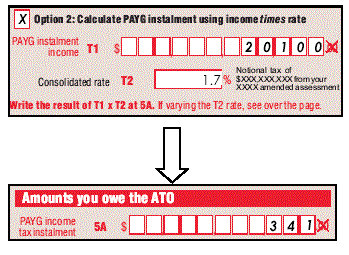Consolidation Reference Manual
You can still refer to the Consolidation reference manual for consolidation information that has not been impacted by changes in the legislation.
C8 PAYG instalments
C8-1 Treatment of PAYG instalments
C8-1-110 Completing the Consolidated activity statement
A head company pays PAYG instalments on a consolidated basis from the date of effect of its consolidated instalment rate - that is, the beginning of the instalment quarter in which the Tax Office first issues the rate. The head company receives a separate activity statement, known as a Consolidated activity statement, to pay these instalments.
This section provides instructions for completing the Consolidated activity statement.
Options for reporting and paying PAYG instalments
The Consolidated activity statement for the first quarter of an income year shows the payment option or options available to the head company.
The head company can use only one option in an income year. Therefore, if the first Consolidated activity statement is for a quarter other than the first quarter of the head company's income year, only one option will be available - the option that was used by the head company in previous quarters of that income year. In this event there will be a pre-printed 'X' in the box next to that option. Boxes you can't use will be clearly marked 'do not complete this option,'
If the head company is eligible for an additional option, this will be available in the first activity statement of the next income year.
The options for reporting and paying PAYG instalments on a consolidated basis are broadly the same as those available to companies generally:
- •
- Option 1: Pay a PAYG instalment amount advised by the Tax Office, or
- •
- Option 2: Calculate your PAYG instalment amount using the instalment rate x instalment income method.
| Table 1: Eligibility for reporting and payment options | |
|---|---|
| Option 1 | Option 2 |
| Pay a PAYG instalment amount worked out by the Tax Office | Pay a PAYG instalment calculated using the instalment rate x instalment income method |
| Available to: Consolidated groups where the instalment income of the head company is $1 million or less* | Available to: All consolidated groups* |
| * May not be available on first Consolidated activity statement if it is for a quarter other than the first quarter of the income year. | |
Figure 1: A guide to the quarterly Consolidated activity statement
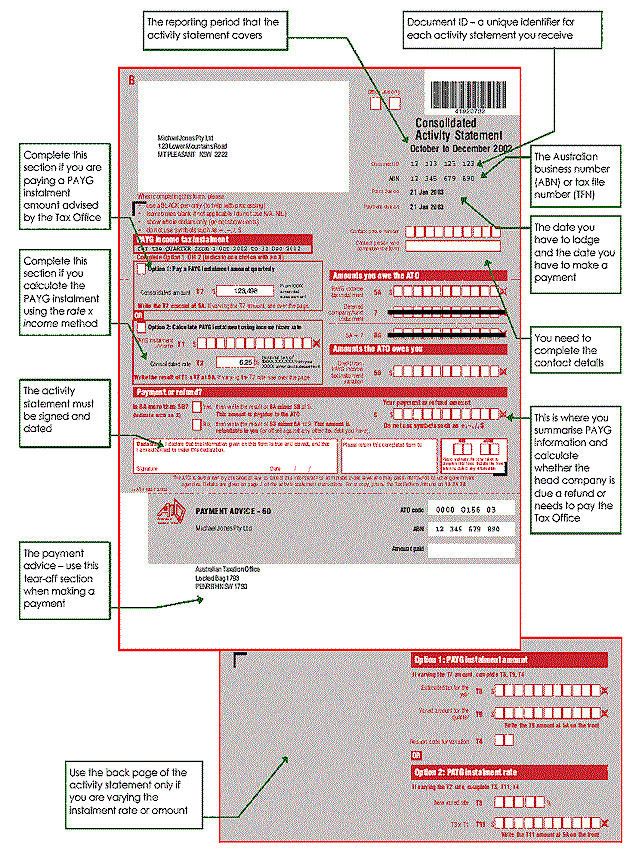
Option 1 - pay amount advised by Tax Office

The Consolidated activity statement will show a PAYG instalment amount at T7 if the head company is eligible to use this option.
To use this option and pay a PAYG instalment amount advised by the Tax Office, write an 'X' in the box.
If the head company elects to pay using option 1 it is required to continue using this option for the rest of the income year. Subsequent activity statements for the income year will have a pre-printed 'X' in the box.
If this option has already been used by the head company during the income year, there will be a pre-printed 'X' in the box.
If this option is unavailable to the head company - either because it is ineligible or because it has used option 2 in a previous quarter of the income year - it will be marked 'do not complete this option,'
T7
Tax Office instalment amount
The PAYG instalment amount shown at T7 is generally an amount calculated by the Tax Office. If the head company varied its instalment amount in a previous quarter of the income year, the varied amount is shown.
To pay the amount shown at T7, transfer it to 5A.
| Example |
|---|
|
The September quarter Consolidated activity statement offers a choice of options. The head company, HCo, decides to use option 1 and pay the instalment amount advised by the Tax Office. HCo writes an X in the option 1 box to indicate its choice. An instalment amount of $5,300 is pre-printed on its activity statement at T7. HCo does not want to vary this amount. It transfers the figure of 5,300 to 5A in the summary section.
|
Vary the instalment amount
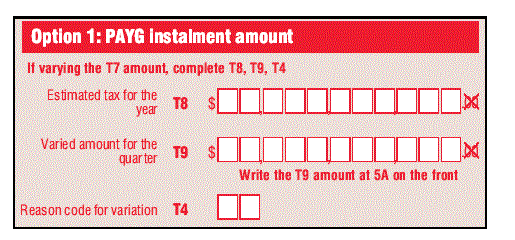
The head company can vary its instalments if it considers that using the amount shown at T7 would result in it paying more (or less) than its expected tax for the income year.
To vary the PAYG instalment amount, complete the 'Option 1' section on the back of the Consolidated activity statement. The head company needs to provide details of its:
- •
- estimated tax for the year, at T8
- •
- varied amount for the quarter, at T9, and
- •
- reason for varying, at T4.
T8
Estimated tax for the year

To vary the head company's PAYG instalment amount, first estimate the expected tax on the group's business and investment income for the year. Write this figure at T8. The Tax Office uses this figure to calculate the instalment amounts for the remaining quarters of the income year.
The head company may be liable to pay the general interest charge if it varies down and underestimates the tax on the group's business and investment income by more than 15%.
T9
Varied amount for the quarter

The varied amount for the quarter depends on which quarter is being considered and the amounts paid in previous quarters. Table 2 sets out the calculations for completing T9 for the relevant period, assuming the head company pays consolidated PAYG instalments from the first quarter of the income year.
If the result of the calculation is a positive amount, write it at T9. If it's a negative amount or zero, write '0' at T9. (If it's a negative amount, you may wish to claim a credit at 5B.)
| Table 2: Varied amount calculation (if head company pays consolidated PAYG instalments from first quarter of income year) | |
|---|---|
| If the instalment quarter is: | The varied instalment amount is: |
| The first in the income year for which the head company is liable to pay an instalment | • 25% of the head company's estimated tax for the income year. |
| The head company's second for that income year |
• 50% of the head company's estimated tax for the income year • minus the amount of the head company's first quarter instalment. |
| The head company's third for that income year |
• 75% of the head company's estimated tax for the income year • minus the amount of the head company's first and second quarter instalments • plus any credit the head company claimed for the second instalment. |
| The head company's fourth for that income year |
• 100% of the head company's estimated tax for the income year • minus the amount of the head company's first, second and third quarter instalments • plus any credit the head company claimed for the second and third instalments. |
Varying in the first year of consolidated PAYG instalments
The information in table 2 assumes that the head company is paying consolidated PAYG instalments from the first quarter of its income year. This will always be the case in the second and subsequent years of the head company's obligation to pay consolidated PAYG instalments.
However, in the first year, the head company's obligation to pay consolidated PAYG instalments may begin in a quarter other than the first quarter of its income year.
If so, the calculation of a varied amount for any consolidated instalment during that income year will need to take into account the PAYG instalment liabilities and credits of group members prior to the date that the head company began paying consolidated PAYG instalments, as shown in table 3.
| Table 3: Varied amount calculation if head company begins paying consolidated PAYG instalments from a quarter other than first quarter of income year | |
|---|---|
| If the instalment quarter is: | The varied instalment amount is: |
| The second in the income year for which the head company is liable to pay an instalment (including earlier instalment obligations of the company that is now the head company)* |
• 50% of the group's estimated tax for the income year** • minus the total of the first quarter instalments of all group members |
| The head company's third for that income year (including earlier instalment obligations of the company that is now the head company)* |
• 75% of the group's estimated tax for the income year** • minus the total of first and second quarter instalments of all group members, including any consolidated instalments of the head company • plus the total (if any) of credits the group members and head company claimed for the second instalment. |
| The head company's fourth for that income year (including earlier instalment obligations of the company that is now the head company)* |
• 100% of the group's estimated tax for the income year** • minus the total of the first, second and third quarter instalments of all group members, including any consolidated instalments of the head company • plus the total (if any) of credits the group members and head company claimed for the second and third instalments. |
|
* That is, include quarters in which the company that is now the head company paid its own PAYG instalments and quarters in which the head company paid consolidated PAYG instalments. For example, if the head company begins paying consolidated PAYG instalments in the second quarter, but paid its own, non-consolidated PAYG instalment in the first quarter, the calculation of the varied amount should be done on the basis that the quarter being considered is the second quarter. ** Including the estimated tax liability of subsidiary members. |
|
T4
Reason code for variation

Choose a reason from table 4 that best describes why the head company is varying its instalment amount, and write the appropriate code at T4.
If the head company is varying because a subsidiary member has joined or left the group, use reason code 33.
| Table 4: Reason codes for varying | ||
|---|---|---|
| Code | Reason | Reason description |
| 21 | Change in investments | Your group's or a subsidiary member's investment strategy or policy has changed and this will significantly affect the group's annual tax liability. For example, the sale or purchase of investments such as shares or property. |
| 22 | Current business structure not continuing | Members of your group have stopped trading or have changed their structure. For example, a member has been permanently closed, it has stopped trading because of a merger or takeover, or it has gone into bankruptcy or liquidation, or been placed in the hands of a receiver or manager. |
| 23 | Significant change in trading conditions | Abnormal transactions relating to your group's income or expenses will significantly affect the group's annual tax liability. For example, a member bought or sold a major piece of machinery or your trading conditions have been affected by local or global competition. |
| 24 | Internal business restructure | Your group has restructured - for example, a member has opened or closed branches, or dropped a major product line - and this will significantly affect your annual tax liability. |
| 25 | Change in legislation or product mix | A change in legislation, or in the product mix of your group, will significantly change your group's annual tax liability. |
| 26 | Financial market changes | Your group contains members who have been affected by domestic or foreign market changes. This reason code is for groups with members involved in financial market trading, including those whose income is affected by changes in financial products, for example, banks, finance and insurance businesses. |
| 27 | Use of income tax losses | Your group will be using income tax losses including capital losses that will significantly affect your annual tax liability. |
| 33 | Variation due to entering or exiting a consolidated group |
A subsidiary member with substantial annual taxable income has either joined or left the group. (This code should be used only by head companies.) |
Calculate amounts owed
5A
PAYG income tax instalment

Transfer the amount at T7 (or T9 if the head company is varying) to 5A on the activity statement.
You can choose to write '0' at 5A instead of the instalment amount if the instalment for the period covered by the activity statement is $50 or less.
5B
Credit from PAYG income tax instalment variation

The head company may be entitled to a credit from earlier instalments for the same income year if it varies the instalment amount and the amount of the instalment worked out at T9 is negative.
If the instalment being varied is the first for the income year, the head company can't claim a credit.
Even if the head company is entitled to a credit, it doesn't have to claim it in the activity statement. Any overpayment of PAYG instalments will be credited to the head company when its annual income tax return is assessed.
To claim a credit, write any negative amount worked out at T9 as a positive amount (don't show the minus sign) at 5B.
Option 2 - calculate instalment using rate x income
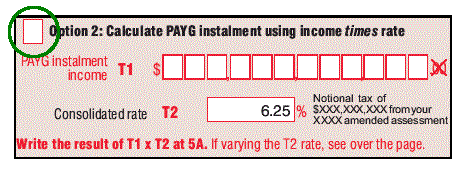
The Consolidated activity statement for the first quarter of an income year will show a PAYG instalment rate at T2.
To use this option and calculate a PAYG instalment amount using the instalment rate x instalment income method, write an 'X' in the box.
If the head company pays using option 2 it is required to continue using this option for the rest of the income year. Subsequent activity statements for the income year will have a pre-printed 'X' in the box.
If this option has already been used by the head company during the income year, there will be a pre-printed 'X' in the box.
If option 1 has already been used by the head company during the income year, option 2 will be marked 'do not complete this option,'
T1
PAYG instalment income

Work out the group's instalment income for the quarter and write this at T1. If the group doesn't have any instalment income for the period, write '0'. Do not leave this box blank.
Consolidated group instalment income is essentially the business and investment income of the group's members for the quarter, excluding transactions between members of the consolidated group.
It includes only ordinary income that would be assessable to the head company of the group if all the members were part of that head company. Transactions between members of the consolidated group are ignored for tax purposes because they amount to accounting entries between parts of the same company and as such are not income and not assessable to the head company.
T2
Instalment rate

The rate pre-printed at T2 will be either:
- •
- the instalment rate worked out by the Tax Office, or
- •
- the most recent varied rate if the head company varied the instalment rate in a previous quarter in the same income year.
To use the rate pre-printed at T2, multiply it by the amount shown at T1 and write the result at 5A.
The head company can vary its instalment rate if it considers that using the rate provided would result in it paying more (or less) than its expected tax for the income year. To vary the instalment rate, complete T3, T4 and T11.
Vary the instalment rate
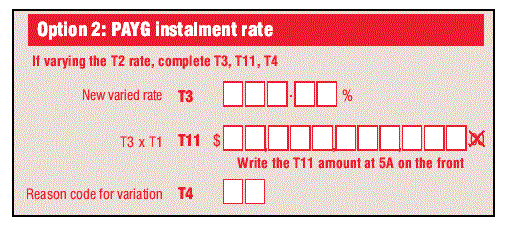
To vary the PAYG instalment rate, complete the 'Option 2' section on the back of the Consolidated activity statement.
The head company needs to provide details of its:
- •
- new varied rate, at T3
- •
- reason for varying, at T4, and
- •
- varied amount calculation, at T11.
T3
New varied rate

Write the new varied instalment rate at T3.
The head company may be liable to pay a general interest charge if it varies down and underestimates the tax on its business and investment income by more than 15%.
T4
Reason code for variation

Choose a reason from table 4 that best describes why the head company is varying its instalment amount, and write the appropriate code at T4.
If the head company is varying because a subsidiary member has joined or left the group, use reason code 33.
T11
(T1 x T3)

Multiply the amount at T1 by the new varied instalment rate that you wrote at T3. Write the result at T11 and transfer this amount to 5A.
Calculate amounts owed
5A
PAYG income tax instalment

If the head company is using the rate pre-printed at T2, multiply this rate by the amount shown at T1 and write the result at 5A.
If the head company is varying the instalment rate, transfer the amount you wrote at T11 to 5A.
You can choose to write '0' at 5A instead of the instalment amount if the instalment for the period covered by the activity statement is $50 or less, and the head company is not claiming a credit at 5B.
5B
Credit from PAYG income tax instalment variation

The head company may be entitled to a credit from earlier instalments for the same income year if it varies its instalment rate and the new varied rate at T3 is less than the instalment rate pre-printed at T2.
A credit will be available only if earlier instalments were worked out using a higher instalment rate. If the instalment being varied is the first for the income year, the head company can't claim a credit.
Even if the head company is entitled to a credit, it doesn't have to claim it in the activity statement. Any overpayment of PAYG instalments will be credited to the head company when its annual income tax return is assessed.
You can use the steps below to calculate the amount of credit that can be claimed in the activity statement:
- 1
- Add up the instalment amounts recorded at 5A on the head company's previous activity statements for the income year.
- 2
- Add up any credits the head company has claimed for the income year. These are the amounts recorded at 5B on the head company's previous activity statements for the income year.
- 3
- Subtract the amount at step 2 from the amount at step 1.
- 4
- Add up the head company's instalment income for all earlier quarters in the income year. These are the amounts recorded at T1 on the head company's previous activity statements for the income year.
- 5
- Multiply the amount at step 4 by the new varied instalment rate you wrote at T3 in the current activity statement.
- 6
- Subtract the amount at step 5 from the amount at step 3.
If the result is a positive amount, this is the amount of the credit the head company can claim. If the head company wishes to claim the credit in its activity statement, write this amount at 5B.
| Example |
|---|
|
The July-September quarter Consolidated activity statement offers a choice of options. The head company, HCo, decides to use option 2 and calculate its PAYG instalment for each quarter in the income year. HCo writes an X in the option 2 box to indicate its choice. HCo's income for the quarter is:
The Tax Office calculated instalment rate pre-printed on the activity statement is 1.7%. HCo's instalment income is $20,100 ($22,000 less $2,000 GST plus $100 other income). It calculates the instalment amount to pay as follows:
|
Lodging and paying
The due date for lodging and paying is pre-printed near the top right-hand corner of the activity statement. The activity statement can be lodged and paid in person, by mail or electronically, but should be done on time to avoid interest and penalties. Even if there are no amounts to report for the period, or there is a difficulty paying, it is important to make sure the activity statement is received by the due date.
How to lodge and pay
By mail
Mail the original, completed activity statement with cheque using the pre-addressed envelope provided to one of the following addresses:
From WA, SA, NT, TAS and VIC
Australian Taxation Office
Locked Bag 1936
Albury NSW 1936
or
From NSW, ACT and QLD
Australian Taxation Office
Locked Bag 1793
Penrith NSW 1793
Cheques should be made payable to the 'Deputy Commissioner of Taxation' and crossed 'Not Negotiable'. Don't attach the cheque with pins or staples.
It's important to send the original activity statement, not a copy or a version generated from a commercial software package. Information generated by a commercial software package must be transferred to the original statement.
In person
Payment can be made at Australia Post outlets using the original payment advice form. Payments can be made with cash (a $3,000 limit applies), money order or cheque. EFTPOS is available at most Australia Post outlets for savings and cheque accounts only.
To order additional or replacement payment advice forms phone 13 72 26.
Electronically
Activity statements can be lodged electronically using:
- •
- the electronic commerce interface (ECI) over the internet, or
- •
- the head company's registered tax agent.
To find out more about lodging activity statements electronically, visit www.taxreform.ato.gov.au/esd/esd_main.htm or phone the Tax Office on 1300 139 051.
Payments can be made by:
- •
- direct credit - initiate an electronic payment using internet banking or a banking software package
- •
- BPAY (Biller code 75556) - use your financial institution's BPAY facility to pay by phone or internet (the EFT code on your activity statement is the BPAY reference number), or
- •
- direct debit - the head company's tax agent can arrange to have payment electronically deducted from the head company's bank account.
The Tax Office does not accept credit card payments.
For more information about direct credit or BPAY:
- •
- phone 1800 815 886
- •
- email payment@ato.gov.au
For more information about direct debit:
- •
- phone 1800 802 308
- •
- email eft-information@ato.gov.au
Difficulty lodging and paying on time
Phone the Tax Office on 13 28 66 to check whether alternative arrangements can be made.
The activity statement should be lodged by the due date even if payment will not be made on time. A penalty may be applied if the activity statement is not lodged on time, and the general interest charge will be applied to any amount not paid by the due date.
Mistakes
Correct mistakes by striking out the error in black pen. Write the new information as close as possible to the boxes for the label. Tape whiteout can also be used to correct errors but liquid whiteout causes problems with scanning.
After lodging the activity statement
Generally a revised activity statement will need to be lodged to correct an error. Phone the Tax Office on 13 28 66 to obtain a revised activity statement.
Refunds
Generally refunds can only be paid directly into the nominated financial institution account, so it's essential that the Tax Office has the correct account and BSB numbers for the head company. The nominated account must be at a branch of the institution in Australia.
The Tax Office may not issue a refund where a previous activity statement hasn't been lodged or if incorrect bank details have been provided.
Contact the Tax Office on 13 28 66 to change financial institution account details.
Record keeping
Keep a copy of the activity statement and the records used to prepare it for five years after they are prepared, obtained or the transactions completed, whichever is the later, in writing and in English.
Current at 28 May 2003


